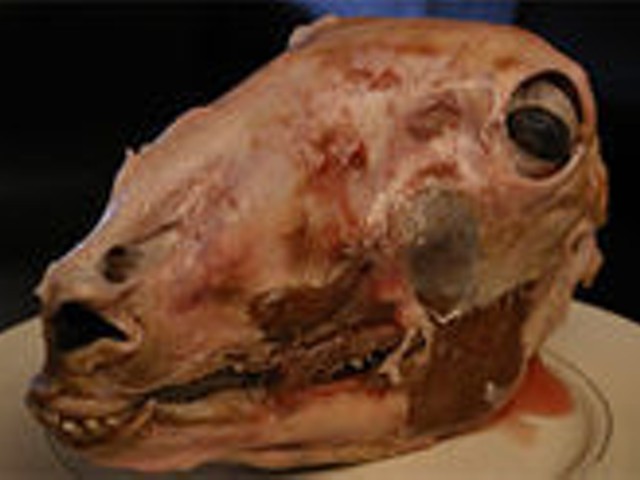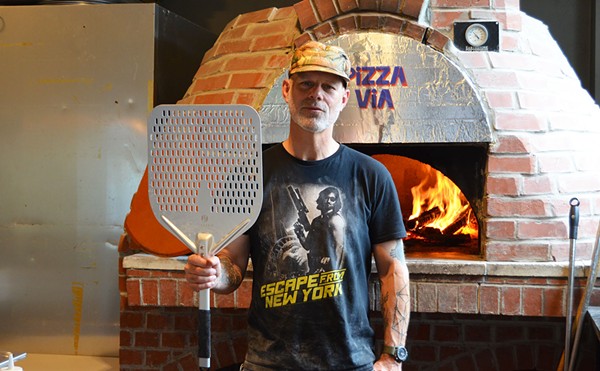Gontram concentrates on the front of the house these days. (I'm fairly sure I saw him hustling hot plates to a waiting table.) His executive chef, Nick Miller, replaced Andy White, who took over the kitchen at Balaban's earlier this year.
A decade is a lifetime in restaurant years, but under the direction of Gontram and Miller, Harvest continues to offer the attention to detail and generous spirit of a restaurant in its prime. Each course arrives exactly when you're ready for it — a few minutes after the previous course has been cleared, precious time to savor the wine and the company. Your check is presented only when you ask.
Should you struggle to pick a wine from the lengthy list, the menu recommends a white and a red, both available by the glass or the bottle, both enthusiastically annotated. The 2004 Cantena malbec "will rival any wine on our list at twice the price.... Enjoy this wonderful wine with our meatier dishes." It is an excellent wine for the money, full of spice and berries, and I think it would have paired well with our meatier dishes — in particular with a braised lamb shank entrée (more about that in a moment) — had my companions and I not finished the bottle with our appetizers.
We could have ordered a second bottle of wine to go with those appetizers. There were four of us that evening, but the three appetizers we chose were so bountiful that we polished off only one, a crab cake — and only because I kept picking at it, amazed that someone in this town knows how to make a good crab cake. (The secret? Not diced peppers. Not corn. Not salsa or spicy remoulades or tartar sauce. Crab. Lump meat. Lots of it. Who knew?)
Fritto misto included green beans and carrots as well as very tender calamari with a garlic aioli. The batter was just right, crisp on the squid and lightly applied to the vegetables. Rosemary-onion flatbread was essentially a pizza without tomato sauce, the thick, fragrant bread topped with excellent apple-chicken sausage.
An entrée of grilled duck breast in a blueberry vinaigrette was served off the bone, a fan of slices atop a generous mound of roasted asparagus, tomato and fingerling potatoes. The duck was perfectly cooked — browned skin, just a crescent moon of skin and then the rich, tender meat — but the blueberry vinaigrette had dissipated across all those vegetables. I tasted sweetness and tartness, but nothing that really said blueberry. Seared scallops were done just right, and the pea risotto that accompanied them was fantastic, soft and creamy and sweet. A special, two plump lamb chops with ramps and Brussels sprouts, was like spring on a plate, all verdant sharpness.
Harvest is rightfully well known for its bread pudding, but I was more taken with the carrot cake, moist and rich and accompanied by a scoop of bracing ginger ice cream. On a subsequent visit I ordered the flourless chocolate cake, which was decadent but unsurprising — though it came with an excellent homemade strawberry ice cream and thick slices of fresh strawberries.
That second visit began with pillowy Yukon Gold gnocchi with prosciutto and juicy fresh peas — a delightful contrast in texture — topped with a quivering poached egg. You break open the egg to create your sauce. An old trick, but effective: It seasons the dish much like a good carbonara sauce. Another appetizer, the charcuterie plate — slices of mild country pâté with mustard and shredded, deeply flavored duck confit — proved ideal for two to share.
When one of us asked our server whether she preferred the hanger steak or the rib eye, the hanger got the thumbs-up. An honest answer, I assume, seeing as how the hanger steak costs several bucks less than the rib eye. The steak came to the table expertly grilled. The presentation was more steak house than bistro, featuring ethereal mashed potatoes, savory homemade steak sauce and crisp onion straws.
Now about that lamb entrée: The shank was served in a rustic natural jus that balanced the mellow, savory character of the braise. It was a satisfying dish, although I wanted a more powerful lamb flavor from the jus; it faded a bit against the cheddar grits on which the shank was served. It occurred to me when it arrived that I hadn't thought to wonder at all about the preparation when I'd ordered it. In fact, if I remember correctly, what I said was: "I'll have the lamb."
What was I thinking? Chops? Grilled kebabs? Roasted leg? Garnished with a traditional sauce cleverly reinvented — a bright green pesto standing in for mint jelly?
Nope, what I was thinking was: I'll have the lamb.
In the four years I've lived in St. Louis, visiting restaurants on my own dime and now reviewing them for the RFT, I've said this phrase or something like it so many times I can't possibly keep count. I'll have the lamb or the duck or the pork or the steak or the short ribs or the salmon or the fresh fish of the day.
If I don't have the crab cake to start, I'll have the butternut squash soup. If I don't have the crème brûlée for dessert, I'll have the flourless chocolate cake.
When you think of St. Louis restaurants, in general, a few categories probably come to mind. Pizza. Old-school fine-dining emporiums like Tony's or Kemoll's. Steak houses. Italian cuisine of questionable provenance.
In 2007, though, our strongest restaurant category may be a nebulous one. Call it New American or Modern Bistro or something else entirely. (Just make sure it's catchy.) It's a mix of classic rustic dishes, topnotch ingredients — preferably, local, in-season and organic — maybe a dash of fusion and a soupçon of showmanship.
The restaurants aren't identical: Moxy looks nothing like Atlas. Franco's cuisine has a French accent, while 1111 Mississippi's has an Italian note. But at each I could feel confident ordering "the lamb" or "the duck" with nothing more than a cursory glance at the menu to learn the exact preparation or accompaniments.
That way, at least, I'd regain the element of surprise.
I wasn't here when Harvest opened in 1996, so I can only imagine how surprising such a rustic menu, dependent on the seasons and the whims of nature, must have been. The fact that we now have so many restaurants that adhere to a similar mindset is a testament to the continuing success and influence of their local wellspring. And the food is so good, so hearty and comforting, that we return to it again and again.
So the field, as it were, has caught up to Harvest. And while I could tell you that Harvest's pea risotto is the best side dish I've had at any of these restaurants, that its hanger steak ranks a skosh above the strip steak at Atlas but a notch below the hanger steak at Balaban's, what fun is it to split hairs?
When I spoke to Stephen Gontram on the phone, he said something that struck me: that what continues to separate St. Louis from the restaurant culture on the coasts is that our restaurant scene isn't chef-driven.
Agreed. But I'd take it a step further. I think that as diners, we need to actively seek out new chefs as well as old favorites. While we're at it, we need to make clear to those old favorites that we'd like to see something new from them as well. Because although we might know what we love now, that's not half as exciting as not knowing what we'll love in the future.
Have a suggestion for a restaurant the Riverfront Times should review? E-mail [email protected]. <





